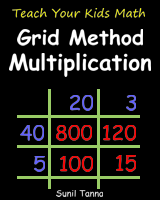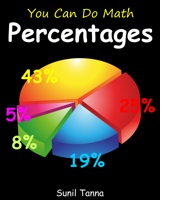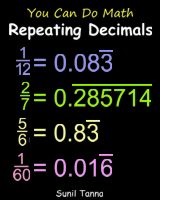| Welcome |
| Ciphers & Codes |
| Computing |
| Dinosaur & Other Animals |
| Learn Math |
| Science |
| Weight Loss Journey |
| Other Stuff |
| Links |
| About this Site |
Math books by Sunil Tanna include:
 |
Teach Your Kids Math: Adding on Your Fingers
This book is a step-by-step guide for introducing your child to addition. Simple and easy steps and colorful pictures will help you teach this important math skill. Before you know it, they will be able to add two, three or four numbers together, and be ready to move on to the next stage: column addition. Click here for more information |
|
 |
Teach Your Kids Math: Column Addition
This book is a step-by-step guide to teaching your kids how to do column addition. After a brief refresher on adding small numbers using your fingers, the book explains how to write out addition sums, how to perform simple column additions, carrying between columns, and finally adding more than two numbers. The book contains five chapters, each with lots of colorful examples and twenty questions and answers (100 questions and answers total in the book). This is the ideal guide to helping your children master this important mathematical skill. Click here for more information |
|
 |
Teach Your Kids Math: Multiplication Times Tables
Knowing multiplication tables is a key math skill. This is because multiplication tables are not only directly useful, but are also a foundation upon which other mathematical techniques are based - including multiplication of larger numbers, division, and fractions. This book is a concise guide for parents showing them, step-by-step, how to successfully teach their kids times tables with the absolute minimum amount of pain. The book contains tons of tips, tricks, and techniques to help with learning, as well as numerous times table and number facts. Click here for more information |
|
 |
Teach Your Kids Math: Grid Method Multiplication
The grid method (also known as the box method) is the way that most children today learn to multiply large numbers. It can seem baffling to parents who learnt traditional long multiplication - but this step-by-step guide solves that problem! This book contains step-by-step explanations, numerous colorful examples, as well as questions and answers (100 in total) to help you and your children master the grid method in next to no time. Click here for more information |
|
 |
You Can Do Math: Working With Fractions
This is a complete introduction to learning, understanding, and mastering working with fractions (sometimes known as "common fractions", "simple fractions", or "vulgar fractions"), and is based on the author's personal experience providing 1:1 mathematics tuition to both school students and adult numeracy students. Every topic is explained in detail, complete with many step-by-step worked examples and diagrams. Additionally. major topics are immediately followed by a set of practice questions (there are well over 300 questions in total in the book), the answers to which can be found at the end of each chapter. In summary, whether you want to learn fractions yourself, or teach your kids fractions, or are a student preparing for exams such as GCSEs or high school maths tests, or are an adult learner wishing to improve your numeracy and knowledge of this important math topic - this book is ideal for you. Click here for more information |
|
 |
You Can Do Math: Percentages
This book will teach you about percentages and how to do calculations involving percentages. Most calculations can be done with and without a calculator. The questions and answers (which show you how to solve percentage problems) at the end of chapters will help you master this important math topic. Click here for more information |
|
 |
You Can Do Math: Repeating Decimals
This book is a complete introduction to repeating decimals (also known as "recurring decimals"), and is based on my personal experience providing 1:1 mathematics tuition to both school students and adult numeracy students. Before beginning this book, you should be comfortable with basic arithmetic, including working with decimals and fractions. Some of the topics covered in this book include different notation for repeating decimals, unambiguous spoken-English descriptions for repeating decimals, the difference between rational and irrational numbers, the relationships between different types of decimals and rational and irrational numbers, and converting repeating decimals into fractions. Every topic is explained in detail, complete with many step-by-step worked examples. Additionally. major topics are immediately followed by a set of practice questions, the answers to which can be found at the end of each chapter. Click here for more information |
|
 |
You Can Do Math: Arithmetic Sequences
A detailed guide to arithmetic sequences (also known as arithmetic progressions), including how to identify them, how to find the terms, creating formulae to describe the terms of an arithmetic sequences, calculating the sum and mean of an sequence, and more. Easy-to-follow step-by-step explanations, numerous examples, and 80 questions and answers - including showing you to solve each question and reach the answer. Click here for more information |
|
 |
You Can Do Math: Radians & Steradians
Radians are the standard unit used by mathematicians and scientists for measuring angles. Likewise, Steradians are the standard unit used for measuring solid angles. This book explains the concepts behind radians and steradians, including how to convert radians to and from degrees, and using radians to calculate arc lengths, chord lengths, and the perimeters and areas of sectors and segments within a circle. There are also worked examples showing how radians are used in practise as well as questions (and answers) so you check your understanding of the topics covered. Click here for more information |
|
 |
You Can Do Math: Scientific Notation, Engineering Notation and Standard Form
This book provides a complete guide to scientific notation (known in the UK as standard form) and engineering notation. It explains how the notation works, the advantages of using it, how to convert to and from it, how to compare numbers and orders of magnitude, and even how to perform approximate arithmetic operations (without using a calculator) such as addition, subtraction, multiplication, division, exponentiation, square roots, cube roots, and logarithms on numbers in scientific notation. There are over 200 questions and answers (answers explain how to get the answer) to help you master this important math topic. Click here for more information |
|
 |
You Can Do Math: Powers, Exponents, Indices and Surds
Exponentiation, raising a number to a power, is usually the next mathematical operation that students learn about after mastering addition, subtraction, multiplication and division. This book is principally about exponentiation and performing mathematical operations on expressions that involve exponents. Additionally, the book introduces surds such as square roots, and explains how to perform common mathematical operations involving such surds. Click here for more information |
|
 |
Amazing Math: Introduction to Platonic Solids
The study of polyhedra (many sided 3D shapes) is an important topic in geometry, and as a fascinating mathematical subject. This beautifully-illustrated book is a comprehensive guide to the 5 Platonic solids (regular tetrahedron, cube, regular octahedron, regular dodecahedron, and regular icosahedron). These solids are important in mathematics and nature, and the only types of convex regular polyhedra that exist. Some familiarity with basic trigonometry and very basic algebra (high school level) will allow you to get the most out of this book - but please note: in order to make this book accessible to as many people as possible, I have included a brief recap on some necessary basic concepts from trigonometry (such as sine, cosine, radians, etc.). Click here for more information |
|
 |
Math Magic: Amazing Tricks With Numbers, Arithmetic & Geometry!
This book is a complete is a guide to 40 math-based magical tricks. The instructions for each trick explain what props or accessories are needed (for example playing cards or calculator), how the trick appears to the audience, how to perform the trick, and in many cases, the mathematical secrets behind the trick. This book is ideal for magicians looking for something new and different to add to their acts, those who simply want to amaze their friends, and for mathematics teachers and educators who wish to inspire their students with fun and interesting mathematical ideas. Click here for more information |
|
...More books coming soon!